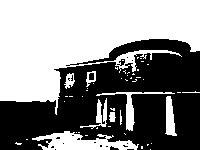Two Bowdoin students this summer are creating an intertidal zone in the Grand Manan Museum. They have been asked to start painting a huge mural that depicts the tidal zone’s marine life as well as the industries, such as clamming and dulsing, that rely on the tides. Emily Weyrauch ’17 checks in with the two artists mid-project for her latest installment of stories on Kent Island life.

Isaac Jaegerman ’16 and Tracey Faber ’16 work in acrylic paints for their intertidal zone mural
One hundred and sixty miles northeast of Bowdoin’s campus, across the Canadian border and through the Bay of Fundy, two Bowdoin students stand surrounded by paint containers and photographs at the bottom of a tiny spiral stairwell in a community history museum.
This summer, Tracey Faber ’16 and Isaac Jaegerman ’16 are creating a life-size mural of the intertidal zone — the area that is under water during high tide and exposed during low tide — at the Grand Manan Museum on Grand Manan Island, a neighboring island of Kent.
The mural project, which was made possible by two Bowdoin Scientific Station artist-in-residence fellowships and funded in part by the province of New Brunswick’s exhibit renewal grant, focuses on the cultural, economic and biological importance of the intertidal zone of Grand Manan. The stairwell is 19.5 feet high, which is about the same height as the tides on Grand Manan. Each wall of the stairwell focuses on a different aspect of the intertidal zone: Faber is highlighting the clamming industry; Jaegerman is concentrating on dulsing (harvesting the edible seaweed dulse); and lead artist (and Grand Manan native) Sara Griffin is painting the organisms that live in the intertidal zone at high tide.
The biologically accurate mural was inspired by Grand Manan Museum Director and Curator M.J. Edwards’ desire to introduce more biology into what is mainly a historical and cultural museum in the fishing community of Grand Manan. “It occurred to me that we just need more science in the Museum,” Edwards said. “What we’re trying to do is combine those two things [art and science] and make it appealing visually.”
Bowdoin Scientific Station Director Damon Gannon said the project is good blending of science and art, “which is very much exactly what our artist-in-residence program is all about.”
Faber and Jaegerman spent their first two weeks on Kent Island taking photographs of the intertidal landscape, researching the species with the help of Gannon and lab instructor Janet Gannon, and sketching ideas for the mural.
“We want to represent what the intertidal actually looks like, while also having it have a degree of scientific accuracy that gives people an actual sense of this environment and the various relationships that are involved,” said Faber, who spent last summer as an artist-in-residence on Kent Island, painting and writing, and was asked by Gannon to get involved with the current mural project.
At the museum, the artists work from field guides and photographs, creating the expansive intertidal landscape one brushstroke at a time. “What you see in a field guide is really close up and detailed, but when you’re working on a huge wall, you have to do large expanses of these organisms and come up with a way of depicting them that’s realistic and accurate,” said Jaegerman, who is a visual arts major at Bowdoin.
The mural also includes memorial portraits of important Grand Manan community members: dulse harvesters Leroy and Roland Flagg and fisherman/clammer Oliver “Smiles” Green.
Faber and Jaegerman are working eight hours a day, five days a week on Grand Manan. They live on Kent Island for two days a week to do source research for their paintings.
Although Bowdoin Scientific Station fellowships typically have students living at the facilities on Kent Island, Gannon said he wanted to see the student artists be more assimilated into the Grand Manan community. So Faber and Jaegerman have been living in the historical keeper’s house of Swallowtail lighthouse.
Each morning, they commute from their lighthouse cottage on the far north end of the island to the Grand Manan Museum. “It’s very windy and we feel like we’re living in a Wes Anderson movie,” Jaegerman said.
“It’s a really unique opportunity to get to live somewhere where there is a thriving fishery,” Faber added. “It’s interesting to live somewhere where so much of what people do depends on the tide, the time of year, the time of week and the weather.”




